
by Deep Green Resistance News Service | Jan 12, 2016 | Colonialism & Conquest, Indigenous Autonomy
Featured image: September 21, 2012: Members of the Lummi Nation protest the proposed coal export terminal at Cherry Point by burning a large check stamped “Non-Negotiable.” The tribe says they want to protect the natural and cultural heritage of the site. Photo by Indian Country Today Media Network.
By Sandy Robson / Coal Stop
The Lynden Tribune newspaper made the decision to publish a December 23, 2015 opinion piece submitted by Chair John Huntley and President Brad Owens of the Northwest Jobs Alliance (NWJA). The NWJA advocates for the proposed Gateway Pacific Terminal (GPT) project. Their op-ed leveled unsubstantiated, defamatory allegations at unnamed “leadership” of the Lummi Nation, a self-governing Indian Nation, and those allegations could easily be perceived as having been leveled at Lummi Nation as a whole.
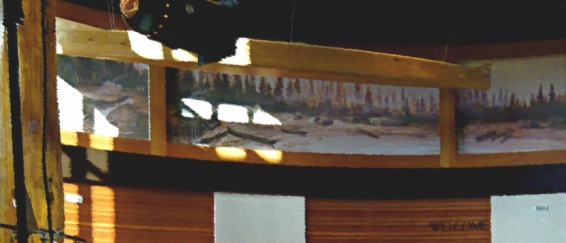
Canoe and murals in the Lummi Administrative Building
The Lummi, a Coast Salish people, are the original inhabitants of Washington state’s northernmost coast and southern British Columbia. The Lummi Reservation is located in western Whatcom County, and it is governed by the Lummi Indian Business Council (LIBC), an eleven member tribal council.
 NWJA’s December 23, 2015 Lynden Tribune op-ed claimed that “the current leadership of the Lummi Nation has embarked upon a campaign against the working families of Whatcom County.” In an attempt to support that inflammatory claim, NWJA pointed to a December 10, 2015 letter from Kirk Vinish of the Lummi Nation’s Planning Department. However, a review of that 2-page letter produced no evidence to support such a claim.
NWJA’s December 23, 2015 Lynden Tribune op-ed claimed that “the current leadership of the Lummi Nation has embarked upon a campaign against the working families of Whatcom County.” In an attempt to support that inflammatory claim, NWJA pointed to a December 10, 2015 letter from Kirk Vinish of the Lummi Nation’s Planning Department. However, a review of that 2-page letter produced no evidence to support such a claim.
In contrast, NWJA has left a trail of evidence demonstrating its continued pattern of negative messaging to raise resentment about, and discredit, the Lummi Nation’s opposition to GPT by sending accusatory letters to the Army Corps and Whatcom County, and by disseminating similar accusatory messaging to the public, via the NWJA email list and a press release sent to local media.
In NWJA’s opinion piece, Huntley and Owens also alleged that Lummi Nation leaders are proposing the elimination of existing Cherry Point industry jobs. They provided no evidence whatsoever to support such a claim.
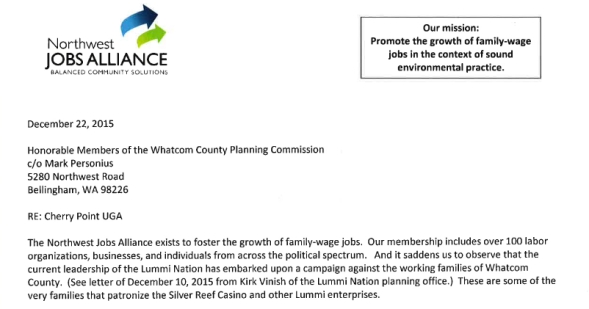
Excerpt from NWJA’s December 22 comment letter to the Whatcom County Planning Commission
As if it weren’t bad enough that NWJA submitted its defamatory op-ed for publication in a local newspaper, the Alliance launched a second strike aimed at Lummi Nation leadership the day before, by submitting a December 22 comment letter to the Whatcom County Planning Commission, on the currently ongoing Whatcom County Comprehensive Plan Update.
The comment letter was a slightly revised version of NWJA’s op-ed published in the Lynden Tribune, containing the same unsubstantiated accusations. NWJA’s inflammatory comment letter is now part of the official public comment record for the County Comprehensive Plan Update which the Whatcom County Council will review prior to voting on the final language to be included in the plan update. The fact that the Council is also one of the decision makers on permits needed by PIT for its GPT project makes NWJA’s comment letter “comprehensively” reprehensible.
GPT threatens Lummi treaty rights
GPT would be sited along the Salish Sea shoreline, at Xwe’chi’eXen, part of the Lummi Nation’s traditional fishing area. Xwe’chi’eXen is the Lummi peoples’ ancestral name for Cherry Point, an area which has a deep cultural, historic and spiritual significance to the Lummi people, as it was a village site for their ancestors for over 175 generations.
The projected coal export terminal threatens Lummi treaty rights, the salmon they depend on, their Schelangen (“Way of Life”), and the cultural integrity of Xwe’chi’eXen. LIBC Chairman Tim Ballew II sent a January 5, 2015 letter to the U.S. Army Corps of Engineers Seattle District Commander, Colonel John G. Buck, asking the agency to take immediate action to deny the GPT permit application.
In that letter, Chairman Ballew stated that the GPT project “will directly result in a substantial impairment of the treaty rights of the Lummi Nation throughout the Nation’s ‘usual and accustomed’ fishing areas.” Ballew also wrote that “The Lummi Nation is opposed to this project due to the cultural and spiritual significance of Xwe’chi’eXen, and intends to use all means necessary to protect it.” He added that the Lummi Nation has a sacred obligation to protect Xwe’chi’eXen based on that significance.

Page excerpt from “Protecting Treaty Rights, Sacred Places, and Lifeways: Coal vs. Communites,” presented by Jewell James, Lummi Tribal Member and Head Carver, Lummi Tribe’s House of Tears Carvers
The U.S. Army Corps of Engineers (“the Corps”) is the federal agency tasked with coordinating and handling the environmental review for the GPT project, and it is legally obligated to ensure that the Lummi Nation’s treaty rights are protected, and are not violated. Currently, the Corps is in the process of making a determination as to whether impacts to any tribes’ U&A (usual and accustomed) treaty fishing rights are more than de minimis, meaning too small or trivial to warrant legal review.

Article VI of the U.S. Constitution which includes the clause that establishes treaties made under its authority, are the supreme law of the land
SSA Marine consultant Craig Cole, Director for NWJA
The Northwest Jobs Alliance (NWJA) was created to promote and advocate for the GPT project. For the first few years, NWJA consisted solely of a Facebook page, after that page had been created in May of 2011. NWJA’s original mission statement that had been displayed for years on its Facebook page read: “The Alliance focuses their efforts on supporting the Gateway Pacific Terminal. . .” For almost three years, NWJA’s Facebook page showed “www.gatewaypacificterminal.com” as its website address, and the phone number displayed had been a non-working number.
Several articles appeared in Whatcom County citizen-based publications during the summer and fall of 2014, criticizing the legitimacy of the NWJA and likening it to a front group, as it did not have a working phone number or a website other than the official GPT website. Subsequently, NWJA made some changes. In fall of 2014, the NWJA added a working phone number, created a website for its online presence, and changed its listed website address on its Facebook page from “gatewaypacificterminal.com” to “NWJA.org.”
Presently, the NWJA website states the following as its mission: “The Northwest Jobs Alliance (NWJA) promotes the growth of family-wage jobs in the context of sound environmental practice.” Also, there is no mention of GPT on the NWJA website’s Home page where the organization’s mission and focus are explained. Instead the general term “Cherry Point industrial area” is used. On October 23, 2014, NWJA was filed as a non-profit corporation, according to the Washington Secretary of State website. SSA Marine’s paid local consultant for the GPT project, Bellingham resident Craig Cole, is the listed Director for NWJA.
On October 23, 2014, NWJA was filed as a non-profit corporation, according to the Washington Secretary of State website. SSA Marine’s paid local consultant for the GPT project, Bellingham resident Craig Cole, is the listed Director for NWJA.
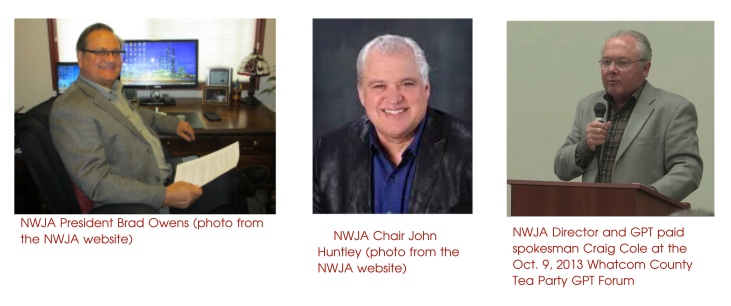 Since its inception, NWJA has had a steady turnover of co-chairs, all of whom have been very public advocates for the GPT project. Presently, Brad Owens is listed as NWJA President and John Huntley is listed as NWJA Chair. Huntley owns Mills Electric, a Bellingham electrical contracting company. Owens, a Bellingham resident, is the past President of the NW Washington Building & Construction Trades Council.
Since its inception, NWJA has had a steady turnover of co-chairs, all of whom have been very public advocates for the GPT project. Presently, Brad Owens is listed as NWJA President and John Huntley is listed as NWJA Chair. Huntley owns Mills Electric, a Bellingham electrical contracting company. Owens, a Bellingham resident, is the past President of the NW Washington Building & Construction Trades Council.
Some people confuse the “Northwest Jobs Alliance” for another similarly titled GPT advocacy organization called the “Alliance for Northwest Jobs and Exports.” It’s worthwhile to distinguish between the two, although promoting the GPT project has been the central intended purpose of both groups.
Cloud Peak Energy and BNSF govern Alliance for NW Jobs & Exports
The Alliance for Northwest Jobs and Exports (ANWJE) was first presented to the public as a grass-roots organization, when it was actually created in 2012, by Edelman, the world’s largest public relations firm, which was hired by SSA Marine to do public relations work for the proposed GPT project.
 According to the Washington Secretary of State website, ANWJE was filed as a non-profit corporationin July 2012. The “Governing Persons” listed are Todd O’Hair and Zak Andersen. Todd O’Hair is currently Senior Manager, Government Affairs for Cloud Peak Energy Inc. which has a 49% stake in SSA Marine/PIT’s GPT project. Zak Andersen is presently Assistant Vice President, Community and Public Affairs for BNSF Railway.
According to the Washington Secretary of State website, ANWJE was filed as a non-profit corporationin July 2012. The “Governing Persons” listed are Todd O’Hair and Zak Andersen. Todd O’Hair is currently Senior Manager, Government Affairs for Cloud Peak Energy Inc. which has a 49% stake in SSA Marine/PIT’s GPT project. Zak Andersen is presently Assistant Vice President, Community and Public Affairs for BNSF Railway.  BNSF is the applicant for GPT’s interrelated Custer Spur project and would be the railway transporting coal mined in Montana and Wyoming to GPT. ANWJE’s website describes its group as a “non-profit trade organization that supports new export projects in Oregon and Washington State…”
BNSF is the applicant for GPT’s interrelated Custer Spur project and would be the railway transporting coal mined in Montana and Wyoming to GPT. ANWJE’s website describes its group as a “non-profit trade organization that supports new export projects in Oregon and Washington State…”
BNSF Railway, SSA Marine, and Cloud Peak Energy are listed on the ANWJE’s membership list, which is comprised of companies and other entities which stand to benefit financially from the coal export terminal. So, this “non-profit trade organization” was created by the public relations firm hired by the GPT applicant, and it is governed by an employee of BNSF, the applicant for the interrelated Custer Spur project, and by an employee of Cloud Peak Energy, which has a 49% stake in SSA Marine/PIT’s GPT project.
NWJA’s attempt to drive public opinion against Lummi opposition to GPT
Whatcom Tea Party board member Kris Halterman hosts a local Whatcom County KGMI talk radio show, “Saturday Morning Live” (SML). On her September 12, 2015 SML show, Halterman hosted NWJA President Brad Owens, and together, they advanced an unsubstantiated, defamatory assertion that NWJA (the entity behind the Lynden Tribune op-ed) had previously purported in its August 20, 2015 letter to the Corps—that there is “an apparent motive behind the Lummi Nation’s opposition to the Gateway Pacific Terminal project (and completion of the EIS process)not connected with treaty rights.” [italicized emphasis theirs]
Joining in those activities against Lummi opposition to GPT, was the Political Action Committee SAVEWhatcom, headed up by Halterman, whose name pops up in most everything GPT-related. The SAVEWhatcom PAC was the vehicle for Gateway Pacific coal terminal interests to fund 2013 and 2014 local Whatcom County election political campaigns with over $160,000, which, if successful, would benefit those interests.

February 5, 2015 post from the SAVEWhatcom Facebook page
One month after the LIBC’s January 5, 2015 letter to the Corps, Halterman’s SAVEWhatcom placed a February 5 post on its Facebook page which disparaged the Lummi Nation and its Silver Reef Casino in what appeared to be an attempt to drive public opinion against the Lummi Nation’s strong oppositional stance to GPT.
Then, in an August 12, 2015 comment letter to the Whatcom County Planning Commission, NWJA seemed to pit “working families” who were characterized in the letter as “some of the very people who patronize Lummi enterprises”— against what was described as “tribal aspirations.” Echoing that previous tack of drawing attention to the Lummi Nation’s enterprises while at the same time denigrating the Nation with groundless claims, the NWJA referenced the Lummi Nation’s Silver Reef Casino in their December 23, 2015 Lynden Tribune op-ed. That excerpt read:
“And it saddens us to observe that the current leadership of the Lummi Nation has embarked upon a campaign against the working families of Whatcom County. These are some of the very families that patronize the Silver Reef Casino and other Lummi enterprises. Some thanks.”
Those specific repeated references to the Lummi Nation’s Silver Reef Casino and enterprises by SAVEWhatcom and the SSA Marine consultant-led NWJA, could be viewed as attempts to drive public opinion against the Lummi Nation’s Silver Reef enterprises—trying to change the minds of the Silver Reef’s loyal patrons who enjoy the hotel, spa, casino, entertainment/shows, multiple restaurants, convention and event venue, and more.
NWJA omits important statistics
NWJA’s December 23 opinion piece failed to mention that the Lummi Nation’s Silver Reef Hotel Casino & Spa employs 675 people. It also failed to mention any of the significant contributions from the Lummi Nation to Whatcom County’s community at large, which certainly have a positive impact on countless families and individuals in Whatcom County. For example, LIBC Chairman Tim Ballew stated in a May 2015 piece in The Bellingham Herald, that Lummi Nation was “humbled and honored to be able to give back to the people who work so hard to make our community thrive,” when referring to its Nation’s donations of over $600,000 awarded to 43 organizations. Some of those organizations include the Bellingham Food Bank, the Whatcom Literacy Council, and Whatcom County Fire District 8, to name a few.
NWJA stated in its December 23 op-ed and its December 22 comment letter to the County Planning Commission, that “Whatcom County ranks 30th out of 39 counties for personal income growth [Bellingham Herald 11/19/15].” In reading The Bellingham Herald article cited as a source for that statistic, NWJA did not bother to inform readers that while the per capita personal income average in Whatcom County increased 3.2% from 2013 to 2014, placing it 30th out of 39 counties in the state, Whatcom County’s 2014 per capita income total ranks 16th highest out of Washington’s 39 counties.
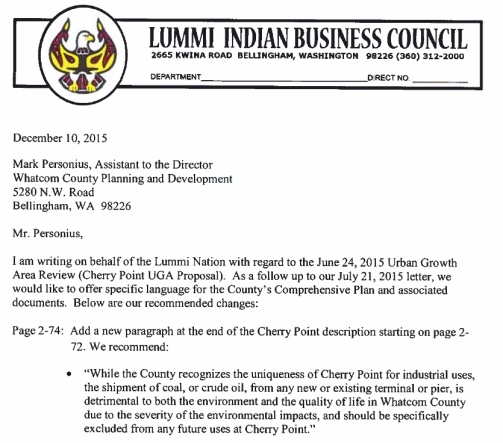
Excerpt from December 10, 2015 comment letter submitted to Whatcom County Planning and Development by the Lummi Nation Planning Department
In its December 23 op-ed, and in its December 22 comment letter NWJA sent to the Planning Commission, Huntley and Owens referenced specific language from the December 10, 2015 comment letter from Lummi Nation’s Planning Department submitted to Whatcom County Planning and Development. The specific language was a new policy that Lummi Nation recommended be added to the County Comprehensive Plan:
“The shipment of coal, or crude oil, from any new shipping terminal or pier, or any existing terminal or pier, is prohibited.” Huntley and Owens said they were troubled by the Lummi Nation’s recommendation and wrote:
“This echoes previous requests that the Lummi have made to the County to begin phasing out the Cherry Point heavy industrial zone.” No evidence, however, was provided by the NWJA to show any previous, or even current, requests from Lummi Nation to begin phasing out the Cherry Point heavy industrial zone.
The underbelly of their reasoning
One particular statement NWJA made in its August 12, 2015 comment letter to the County Planning Commission revealed the underbelly of their reasoning:
“The Lummi occupy an important and unique role in our community, but they are just 1.5% of the County’s population.”
NWJA repeated similar statements in its August 27, 2015 email advertisement disseminated via its mailing list, and in its September 10, 2015 press release, potentially indicating to their audiences a reason to marginalize and dismiss Lummi Nation’s voice based on the Lummi’s minority population status.
Just as “Manifest Destiny” mandated that it was supposedly God’s providence that the U.S. should exercise hegemony over its neighbors—seeing North America as the new Promised Land, NWJA and the GPT corporate interests they advocate for, seem to believe that it’s their economic providence to exercise hegemony over the Lummi Nation—seeing Xwe’chi’eXen (Cherry Point) and its naturally occurring deep-water contours which allow for huge Capesize vessels stuffed with U.S. coal bound for Asia, as their new Promised Land.
The Lummi Nation, however, and countless people in the Pacific Northwest region, have a very different view of their destiny, and that view does not include the transporting, handling, and shipping of 48 million metric tons per year of coal to Asia, which is the plan for GPT.
Raising resentment of tribal treaty rights; encouraging the public and government officials to ignore tribal treaty rights; calling into question the motivation behind an Indian Nation’s exercising of its tribal treaty rights; interfering with the federal regulatory review process and the government to government relationship between a U.S. federal agency and Indian Tribes and Indian Nations; and making disparaging and unsubstantiated accusations against an Indian Nation and its leaders, are some of the various ways in which the Lummi Nation is being attacked as powerful corporations endeavor to realize their perceived manifest destinies, in pursuit of a coal export terminal at Xwe’chi’eXen.
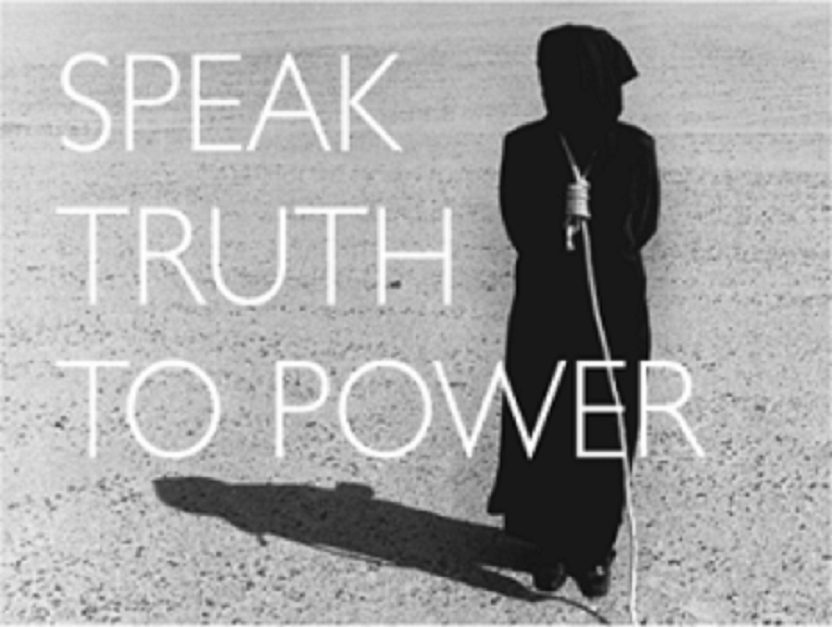
by Deep Green Resistance News Service | Jan 9, 2016 | Culture of Resistance, The Solution: Resistance
By Zoe Blunt / Deep Green Resistance
Featured Image via the Speak Truth the Power Project.
The more we challenge the status quo, the more those with power attack us. Fortunately, social change is not a popularity contest.
Activism is a path to healing from trauma. It’s taking back our power to protect ourselves and our future.
From a spoken-word presentation in Victoria BC, 2009
Thank you for the opportunity to launch my speaking career. Some of you may know me as a writer and an advocate for social and environmental justice. Others may know me as a cat-sitter, odd-jobber, and temp slave. (Laughter)
I knew when I started out as an activist that I would never be a millionaire and I was right. But I have a certain freedom and flexibility that your average millionaire might envy.
The market demand for social justice advocates is huge right now. It’s a growth industry. And the job security is fantastic – there is no shortage of urgent issues demanding our attention. Experience is not necessary, people come to activism at every age and stage in their lives. It’s that easy!
OK, it’s not actually that easy. (Laughter) But it is a fascinating time to be a “radical.”
There is a great tradition of courage and action here on Vancouver Island. There is potential for even greater future action, so we are doing everything we can to nurture that potential. Building community, linking up networks, teaching, learning, coming together, healing – this is all part of the movement.
For most of my adult life, I suffered from social phobia. I was afraid of authority, filled with self-doubt, paralyzed by anxiety. Getting interviewed live on national TV doesn’t make that go away. But hiding under the covers doesn’t cure it either. So my insecurities and I just have to get out there and do our best.
What compels me is the knowledge that we’re rewriting the script – the one that says, “You don’t make a difference. It is what it is, you can’t fight city hall, the big guys always win.” We can remember that we are not powerless. And when we choose to stand up, it is a huge adrenaline rush – bigger than national TV or swinging from a tree top. That’s the reward – that flood of excitement that comes from taking back our power and using it effectively, for the collective good.
It helps to get love letters from friends and strangers who want to thank me for standing up for what’s important, and who get inspired to take action themselves.
But it’s not all warm fuzzies and celebratory toasts. We face backlash and punishment and threats to our lives and safety.
I led a workshop for new activists this year, and I asked them, “Who are your heroes?”
They named a dozen. Gandhi. Martin Luther King. Tommy Douglas. Rosa Parks. These folks led amazing, heroic movements, but our discussion focused on the ferocious backlash they faced. British media reports on Gandhi when he was challenging the monarchy had the same tone as white Southerners responding to Rosa Parks refusing to give up her seat on the bus. It was vicious. “Uppity and no-good” were some of the polite terms. They were targeted with hate speech and death threats. We hear the same now about whistleblowers. And feminists and environmentalists. It can be terrifying.
The more we challenge the status quo, the more the entrenched powers attack us. The more effective we are, the more they attack us. As Gandhi said: “First the ignore you, then they ridicule you, then they fight you, then you win.”
The fight for justice and liberation won’t be won by popularity contests.
Every campaigner finds their own way of dealing with the counter-attacks. Some laugh it off. Some pray, some cry on their friends’ shoulders. Some go on the counter-offensive, some compose songs, some write long academic papers deconstructing their opponents’ logic. The important thing is, they deal with it, and they don’t give up.
We take care of each other as a community. Because we are all so fragile. Because there is so much trauma and despair everywhere and it affects everyone. But inside that despair, in all of us, there is a solid core of love for the earth and the knowledge that we can act in self-defense. That’s where we find strength.
It’s humbling to note that the economic downturn has done more to preserve habitat and stop climate change than all of our conservation efforts of the past years combined. We take responsibility for recycling and turning down the thermostat, but who is responsible for the scale of destruction from the Tar Sands? That project is the equivalent of burning all of Vancouver Island to the ground. It negates everything we could hope to do as individuals to fight climate change.
How do we deal with that horrible reality? I couldn’t, for the first year of the campaign. I didn’t want to look at the pictures and hear the news stories about the water and air pollution and the rates of illness among the Lubicon Cree people. The scale and the horror of it were too great.
I’ve worked on toxics campaigns and I dread them. Old-growth campaigns are inspiring, because where the action is, the forest is still standing – it’s beautiful and magical and we’re defending nature’s cathedral from the bulldozers and chainsaws. The good earth is here, and the evil destructive forces are over there. It’s clearcut, so to speak. But when a toxics campaign is underway, the damage has been done. The landscape is poisoned and people have cancer and spontaneous abortions, and the birds, the fish, the animals, are dead and dying. It is a scene of despair.
If it sounds traumatizing, it is. And we are all traumatized.
Look at this landscape – concrete, pavement, bricks and mortar, toxic chemicals, but underneath, the earth is still there. We have whole ecosystems slashed and burned without so much as a by-your-leave. We’ve lost whole communities of spruce, marmots, murrelets, arbutus, sea otters, and geoducks. These are terrible losses.
And we humans suffer on every level. Is there anyone here who doesn’t know someone who’s had cancer? Who hasn’t seen the damage caused by diseases of civilization? Who here hasn’t been forced to do without for lack of money? Are there any women here who have never been sexually harassed or raped or assaulted?
(Silence)
Something fundamental has been taken from us here. How do we deal with these losses?
I consider myself fortunate because after a lifetime of abuse from my family and male partners, I participated in six months of Trauma Recovery and Empowerment at the Battered Women’s Support Centre in Vancouver.
And I got to know the stages of trauma recovery:
Acknowledge the loss, understand the loss, grieve the loss.
And the stages of grief:
Denial, anger, bargaining, depression, and acceptance.
These steps are a natural and necessary response to the loss of a loved one, and also to the loss of our humanity and the places we love.
There are people living in national sacrifice zones, people who burn with determination to make change. They are angry, and they have a right to be. I am angry because I’m not dead inside, in spite of all they’ve done to me. Anger is part of the process of grief, and it’s useful. It grabs us by the heart when people are hurting the ones we love.
For me, part of the process is taking action – rejecting helplessness and taking back power. Stopping the bleeding and comforting the wounded.
I fall in love with places and I want to protect them. I fell in love with the Elaho Valley and some of the world’s biggest Douglas Firs in 1997. That forest campaign was a pitched battle, far from the urban centers, against one of the biggest logging companies on the coast at that time.
In the third year of the campaign, I walked into my favourite campsite shaded by majestic cedars. I saw the flagging tape and the clearcut boundaries laid out, and I realized it was all doomed. I could see the end result in my mind’s eye: stumps and slash piles as far as the eye could see, muddy wrecked creeks, a smoldering ruin.
I realized no one was going to come and save this place – not Greenpeace or the Sierra Club, no MP’s private member’s bill, or whatever petition or rally was being planned back in the city. It was as good as gone. All we had to do was stand aside and do nothing, and this incredible, irreplaceable forest would be just a sad memory.
But after that realization, and after the despair that followed, I had a profound sense of liberation. If it is all doomed, then anything we do to resist is positive, right? Anything that stops the logging, even for a minute, or slows it down, or costs the company money, or exposes it to public embarrassment and hurts its market share, is positive – it keeps the future alive for that one more minute, one more hour, one more day. It was a revelation.
Acceptance, for me, meant being able to act to defend the place I loved. It meant standing up to the bullies and refusing to let them take anything more from me.
In the third year of the Elaho campaign, it was just a handful of people rebuilding the blockades, defying the court orders and continuing the resistance. We didn’t quit when the police came, or when we were called “terrorists” and “enemies of BC.” We didn’t quit even after 100 loggers came and burned our camp to the ground and put three people in the hospital.
The attack was a horror show. People were in shock. But a crew was back with a new camp five days later. By then, the raid was national news. And our enemies had nothing left to throw at us. The loggers didn’t know what to do next. Short of killing us, what more could they do?
We had called their bluff.
We didn’t know about the negotiations going on behind the scenes. We didn’t realize that we had already cost the loggers more than they could hope to recoup by logging the entire rest of the valley. (They were operating on very slim profit margins.) We found out when the announcement came that the logging would stop. And it never started again. We won. Now the Elaho Valley is protected by the Squamish Nation — and by provincial legislation — as a Wild Spirit Place.
The violence of the mob showed the level of fear and desperation of the losing side. It was their weapon of last resort and it didn’t work. And they lost.
In the fourth year of the stand for SPAET – the campaign to stop the development and protect the caves, the garry oaks, and the wetlands on Skirt Mountain – we faced the same tactics. We were called “terrorists,” and in 2007, the developers sent 100 goons to rough up people at a small rally. And again, most of our comrades are still in shock. There’s only a handful of us still bashing away at the next phase of development.
We are winning. The other side has thrown everything they have at us and they have nothing left.
There are still sacred sites on SPAET. The cave is still there, buried under concrete.
Meanwhile, the developer’s little empire fell apart, either because of our boycott campaign, bad karma, or because it was operating on the slimmest of shady margins. We took the next phase of development to court. Our campaign, and the economic downturn, turned out to be enough to scare off investors and cancel the project, at least for now.
This work is difficult, painful, and traumatic. So the first step to courage is to acknowledge that pain and loss. We need to name what has been taken from us. Then we can cry, and rage, and grieve. We can name the ones who are doing the damage. We can reach down inside and find our core strength and our truth, and use it. That’s where courage comes from.
Martin Luther King said, “Justice shall roll down like waters, righteousness like a mighty stream.” But I’m impatient. I want to see that mighty stream now – what’s the hold-up? What’s holding us back, when there’s so much to do?
We’re not heroes, actually – none of us is smart enough, or tough enough, or connected enough, to take this on alone. We don’t have superpowers. We are only human, we struggle and suffer and sometimes, we win.
Some folks assume I have some vision, some over-arching game plan, some magic power that gives me an edge. Nope. Most of the time I am just flailing around on the political landscape, taking potshots when I see an opening. Sometimes it’s intuition, and it pays off. When we are right, it is amazing. When we win, it sets a precedent for the future.
In order for evil to prevail, all that’s required is for good people to do nothing. Don’t be one of those good people.
Activism is part of the healing. It’s taking action to protect ourselves and our future.
Thank you for the opportunity to tell these stories today.
(Applause)
Also read how Zoe Blunt moved from “flailing around on the political landscape” to strategic activism: Deep Green Resistance: Words as tactical weapons

by DGR Editor | Jan 8, 2016 | Culture of Resistance
Derrick Jensen / Deep Green Resistance
I’ve always kind of hated that quote by Edward Abbey about being a half-hearted fanatic (“Be as I am — a reluctant enthusiast . . . a part-time crusader, a half-hearted fanatic”). Not so much because of the racism and misogyny that characterized some of his work. And not even because of the quote itself. But rather because of how that quote has been too often misused by people who put too much emphasis on the half-hearted, and not nearly enough emphasis on the fanatic.
The fundamental truth of our time is that this culture is killing the planet. We can quibble all we want — and quibble too many do — about whether it is killing the planet or merely causing one of the six or seven greatest mass extinctions in the past several billion years, but no reasonable person can argue that industrial civilization is not grievously injuring life on Earth.
Given that fact, you’d think most people would be doing everything they can to protect life on this planet — the only life, to our knowledge, in the universe. Sadly, you’d be wrong.
I think often of a line by the psychiatrist R. D. Laing, “Few books today are forgivable.” He wrote this, I believe, because we have become so very alienated from our own experience, from who we are, and this alienation is so destructive to others and to ourselves that if a book does not take this alienation as its starting point and work toward rectifying it, we’d all be better off looking at blank pieces of paper. Or better, actually experiencing something (or someone). Or even better, entering, as Martin Buber might have written, into a relationship with something or someone.
I agree with Laing that few books today are forgivable (and the same is true for films, paintings, songs, relationships, lives, and so on), and I agree for the reasons I believe he was giving. But there’s another reason I think few books (films, paintings, songs, relationships, lives, and so on) are forgivable. There’s that little nagging fact that this culture is murdering the planet. Any book (film, painting, song, relationship, life, and so on) that doesn’t begin with this basic understanding — that the culture is murdering the planet (in part because of this alienation; and of course this murder then in turn fuels further alienation) — and doesn’t work toward rectifying it is not forgivable, for an infinitude of reasons, one of which is that without a living planet there can be no books. There can be no paintings, songs, relationships, lives, and so on. There can be nothing.
The conservation biologist Reed Noss has called his field a “combat discipline”: we are in a crisis, and our attitudes and actions need to reflect this. And so I sometimes try to apply the Ed Abbey quote to the work of a firefighter. If you were trapped in a burning building, would you want the firefighters to be reluctant enthusiasts, part-time crusaders, half-hearted fanatics? Should the mother of a very sick child be reluctant or half-hearted in defense of that child?
If you were trapped in a burning building, would you want the firefighters to be reluctant enthusiasts, part-time crusaders, half-hearted fanatics?
I’m not saying we don’t need recreation. I’m not saying we don’t need amusement. Hell, I have three mystery novels in my backpack right now. I’m not saying a firefighter doesn’t need to rest — having hauled seven unconscious people out of the burning building, we could hardly blame the firefighter for grabbing a quick drink of water or sometimes taking a day off; and I’m not saying the mother doesn’t need to sleep or take some time away from the stress of caring and advocating for her child. We all need the occasional escape, or even indulgence. But we must be able to pursue those escapes and indulgences with the knowledge that others are rushing into the burning building, that others have taken over the job of advocating for whatever is necessary to heal that child.
And that, frankly, is part of the problem: there aren’t nearly enough of us working anywhere near hard enough to stop this culture from killing the planet. Obviously, or the world would be getting healthier, instead of being desecrated with ever increasing speed. If there were more of us trying to stop this culture from killing the planet, then those who are working themselves to death could afford to take a little time off and not feel as if things would fall apart while they climbed the mountains or ran the rivers.
“It is not enough to fight for the land,” Abbey continued; “it is even more important to enjoy it. While you can. While it is still there.” But this part of the quote might actually bother me more, in part because of its fatalism and in part because we — humans — are not the point. Yes, absolutely we should enjoy and commune with and make love with and touch and be with and absorb and be absorbed by the land. Yes, absolutely we should sit in the sun and feel it warm our bones, and we should listen to the whispering voices of trees, and we should open our ears and our hearts to the voices of frogs. But when the forests are being flattened and the frogs are being extirpated, enjoying them isn’t enough. So long as there’s still something we can do to protect them, shouldn’t protecting them be far more important than enjoying them? Because, once again, we are not the point. The trees, the frogs, do not exist for us. It is our culture that is killing them, and it is up to us to stop it.
Have you ever had anyone you love die or come to grievous harm needlessly, from some unnecessary act of stupidity or violence? I have. And in the aftermath I have never wished I had spent more time enjoying this other, but rather wishing I had acted differently such that I was able to prevent the unnecessary losses.
As my artist and writer friend Stephanie McMillan wrote in her essay “Artists: Raise Your Weapons”: “If we lived in a time of peace and harmony, then creating escapist, serotonin-boosting hits of mild amusement wouldn’t be a crime. If all was well, such art might enhance our happy existence. There’s nothing wrong with pleasure or decorative art. But in times like these, for an artist not to devote her/his talents and energies to creating cultural weapons of resistance is a betrayal of the worst magnitude, a gesture of contempt against life itself. It is unforgivable.”
I would extend her comments beyond art: in times like these, for anyone not to devote her/his talents and energies to defending the planet is a betrayal of the worst magnitude, a gesture of contempt against life itself. It is unforgivable.
The questions I keep coming back to are these: in this time, as countless multitudes of humans and nonhumans suffer for the profits and luxuries of a few, and as species go extinct at rates greater than any in the last scores of millions of years — as large-vertebrate evolution itself is being halted — what does the world need? What does the world need from me?
I want to be very clear: I don’t mean to imply that we shouldn’t love the world or each other (human or nonhuman). Or that we shouldn’t play games or have fun. I’m not saying we shouldn’t rest or go hiking or read good books (and Desert Solitaire is a great book). I’m not even saying I have a problem with Abbey’s quote as such; my main problem with the quote is the many would-be activists who use it as an excuse for inaction.
We are in a crisis, and we need to act as such. We need to rescue people from the burning building. We need everybody’s help.
Original published in the July/August 2010 issue of Orion
Photo Credit: US Forest Service, Apache-Sitgreaves National Forest
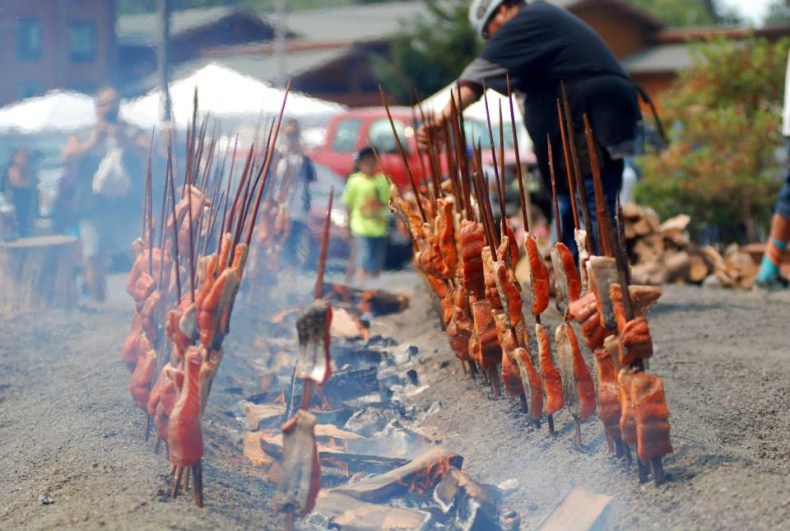
by DGR Colorado Plateau | Dec 29, 2015 | Indigenous Autonomy
By Dan Bacher / Intercontinental Cry
Featured image: Salmon Barbecue at the 53rd Klamath Salmon Festival (photo: Yurok Tribe/Facebook)
The Yurok Tribe, the largest Indian Tribe in California with over 6,000 members, has banned genetically engineered salmon and all Genetically Engineered Organisms (GEOs) on their reservation on the Klamath River in the state’s northwest region. The Yurok ban comes in the wake of the federal Food and Drug Administration (FDA) decision on November 19 to approve genetically engineered salmon, dubbed “Frankenfish,” as being fit for human consumption, in spite of massive public opposition to the decision by fishermen, Tribes, environmental organizations and public interest organizations.
On December 10, 2015, the Yurok Tribal Council unanimously voted to enact the Yurok Tribe Genetically Engineered Organism (“GEO”) Ordinance. The vote took place after several months of committee drafting and opportunity for public comment, according to a news release from the Tribe and Northern California Tribal Court Coalition (NCTCC). This ordinance is apparently the first of its kind in the U.S. to address the FDA’s approval of AquaBounty Technologies’ application for AquAdvantage Salmon, an Atlantic salmon that reaches market size more quickly than non-GE farm-raised Atlantic salmon, as well as all GMOs.
“The Tribal GEO Ordinance prohibits the propagation, raising, growing, spawning, incubating, or releasing genetically engineered organisms (such as growing GMO crops or releasing genetically engineered salmon) within the Tribe’s territory and declares the Yurok Reservation to be a GMO-free zone. While other Tribes, such as the Dine’ (Navajo) Nation, have declared GMO-free zones by resolution, this ordinance appears to be the first of its kind in the nation,” the Tribe said.
“On April 11, 2013, the Yurok Tribe enacted a resolution opposing genetically engineered salmon, and then secured a grant from the National Congress of American Indians (NCAI) to support the Tribe’s work in continuing to protect its ancestral lands, including: waters, traditional learning and teaching systems, seeds, animal-based foods, medicinal plants, salmon, sacred places, and the health and well-being of the Tribe’s families and villages. GMO farms, whether they are cultivating fish or for fresh produce, have a huge, negative impact on watersheds the world over,” the Tribe stated.
“The Yurok People have managed and relied upon the abundance of salmon on the Klamath River since time immemorial. The Tribe has a vital interest in the viability and survival of the wild, native Klamath River salmon species and all other traditional food resources,” the release said.
James Dunlap, Chairman of the Yurok Tribe, said, “The Yurok People have the responsibility to care for our natural world, including the plants and animals we use for our foods and medicines. This Ordinance is a necessary step to protect our food sovereignty and to ensure the spiritual, cultural and physical health of the Yurok People. GMO food production systems, which are inherently dependent on the overuse of herbicides, pesticides and antibiotics, are not our best interest.”
The Ordinance allows for enforcement of violations through the Yurok Tribal Court. Yurok Chief Judge Abby Abinanti stated, “It is the inherent sovereign right of the Yurok People to grow plants from natural traditional seeds and to sustainably harvest plants, salmon and other fish, animals, and other life-giving foods and medicines, in order to sustain our families and communities as we have successfully done since time immemorial; our Court will enforce any violations of these inherent, and now codified, rights.”
The Yurok Tribe is working with other Tribes in a regional collaborative as part of the Northern California Tribal Court Coalition (NCTCC), and the Tribe and NCTCC are co-hosting an Indigenous Food Sovereignty Summit in Klamath in the spring of 2016. A signed copy of the ordinance can be found on NCTCC’s website.
The Tribal Council passed the ordinance at a critical time for West Coast salmon and steelhead. The Klamath River, located on the Tribe’s homeland, is plagued by massive algal blooms, exacerbated by agricultural runoff and antiquated hydroelectric dams, that turn the river toxic each summer. The Tribe is working with other Tribes, environmentalists, fishing groups and elected officials to remove four dams on the Klamath River to restore the river’s salmon, steelhead and other fish populations. The Tribe in September withdrew from the controversial Klamath Agreements and in December announced it “strongly opposes” draft legislation from US Representative Greg Walden of Oregon to address Klamath River Basin water issues.
The Klamath’s salmon and other fish populations are also threatened by Jerry Brown’s California Water Fix to build the Delta Tunnels. The massive tunnels proposed for construction under the Sacramento-San Joaquin River Delta, the largest estuary on the West Coast of the Americas, would export water to corporate agribusiness interests, Southern California water agencies and oil companies conducting fracking and other extreme oil extraction methods in Kern County.
A large proportion of the water of the Trinity River, the Klamath’s largest tributary, is diverted from Trinity Reservoir to the Sacramento River basin via Whiskeytown Reservoir to irrigate almonds, pistachios and other crops on drainage impaired land in the Westlands Water District on the west side of the San Joaquin Valley. The giant tunnels would imperil Chinook salmon, coho salmon, steelhead and lamprey populations on the Trinity and Klamath rivers, as well as hastening the extinction of Sacramento River winter-run Chinook salmon, Central Valley steelhead, Delta and longfin smelt, Sacramento splittail and green sturgeon populations.
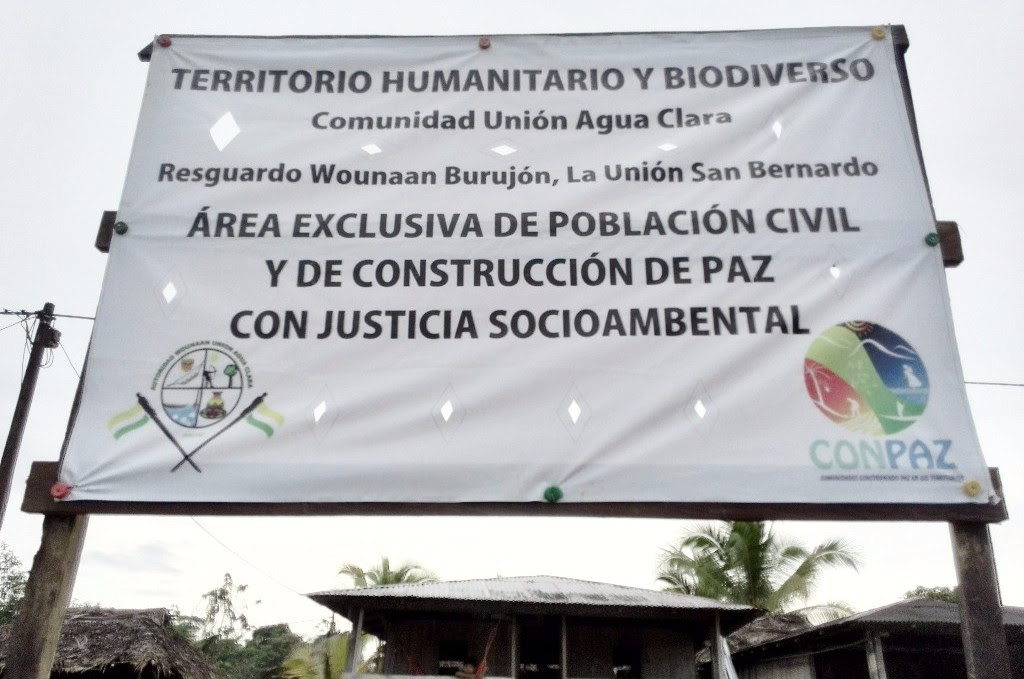
by DGR Colorado Plateau | Dec 27, 2015 | Colonialism & Conquest, Indigenous Autonomy
By Mary Cappelli
Featured image: Wounaan Banner, reading:
Humanitarian and biodiverse territory
Community of Union Aguas Claras
Reservation of Wounaan Burujon, La Union San Bernardo
An exclusive area of civilians and peacebuilding and justice
The Wounaan Tribe of Northwestern Colombia’s San Juan River is the latest casualty of a violent 25 year reign of terror hastened by the convergence of coca growers, gold miners, paramilitaries, guerillas, and government troops—all vying for control of the waterways and resources along the ancestral stretch of traditional Wounaan territories. Until the arrival of mono-crop production for export, Wounaan’s steadfast strategies have thwarted the bloodied battlefields of Spanish colonial impositions, nationalist armies, and Marxist guerrillas.
Occupying small thatched huts stilted on posts hovering up to eight feet high along the clearings on the riverbanks, the Wounaan kept to their subsistence livelihoods of hunting, fishing, Werregue Palm basket-weaving, and small-scale agriculture of bananas, pineapples, and yucca. That is until November 2014 when the Wounaan Tribe was forced to leave their village of Unión Aguas Claras along the San Juan river of the Cauca Valley and take up a 12-month residence in El Cristal Sports Arena in Buenaventura, Colombia.
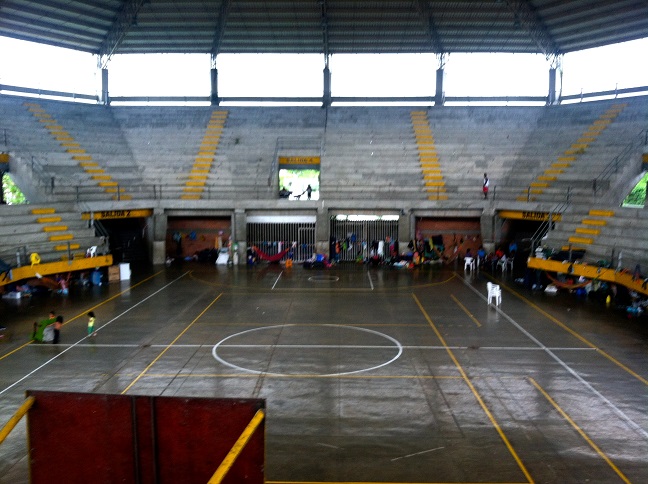
According to Wounaan spokesman Crelo Obispo, “Paramilitaries kicked us out of land” and for twelve months they worked diligently to “find a peaceful way to recover our own indigenous land.” The Wounaan turned their occupation into a form of civil disobedience and refused to return to their lands without adequate protection and security from warring factions. Although on November 29, 2015, they returned home along the San Juan River, their cultural survival signals a critical humanitarian and environmental emergency in which indigenous people living sustainable lives have been caught in a resource war for coca cultivation, gold mining and control of key river tributaries.
Occupy El Cristal
For a full year, 343 Wounaan people, 63 families, occupied the cold hard floor of the basketball courts sleeping in multi-colored hand-woven hammocks strung beneath the stadium bleachers. One of them was a young wearied mother holding a shirtless 11 month-old infant suffering from a burning fever and bouts of diarrhea and vomiting. She recalled: “There wasn’t any medicine.” Herein lies the crisis. Not only were mothers unable to gain access to traditional herbal medicines, they were also unable to gain access to modern health care. Three somber mothers told me they were running out of adequate food and water sources. Buenaventura Officials confirmed the death of two young children, one year-old Neiber Cárdenas Pirza in December 2014 and a two day-old baby in June 2014. The Wounaan claimed the deaths were a result of inadequate health care and living conditions in the sports arena. “Our people practice culture, artistry, spirituality and traditional medicine. We need our lands to do so,” said Obispo.

The affirmative belief that the Wounaan were “occupying” the sports arena and taking a political stand against their dispossession by violence is key to understanding Wounaan resistance. “We arrived November 28, 2014 and since that time we had been in resistance,” Chama Puto said. Because the “the local government hardly did anything, and gave no guarantees of assistance,” he urgently called on international help and social advocacy networks to “get meetings with entities who could make change” and affirmed Wounaan ancestral ties to their lands. “Land doesn’t belong to the government or police. It belongs to the indigenous,” he added.
The occupation of El Cristal is an example of how Indigenous peoples enact visibly distinctive resistance tactics to draw political and social mobilization to defend their right to living in their native territories. Although Wounaan Leaders such as Chama Puto are well versed in Colombia’s constitutional law, they are fully aware of how constitutional decrees have remained rhetorical discourses because of the government’s failure to implement constitutional protections within its infrastructure—an absence of institutional support that has undermined the visionary purpose of the protections. In particular, Article 63 states: “Communal lands of ethnic groups and reservation lands cannot be taken away or attached”; Article 72 states: “Ethnic groups settled in areas of archeological treasures have special rights over that cultural heritage, which rights must be regulated by law”; Article 246 provides that “the authorities of the indigenous peoples may exercise jurisdictional functions within their territories, in accordance with their own standards and procedures, provided they do not conflict with the Constitution and laws of the Republic.”
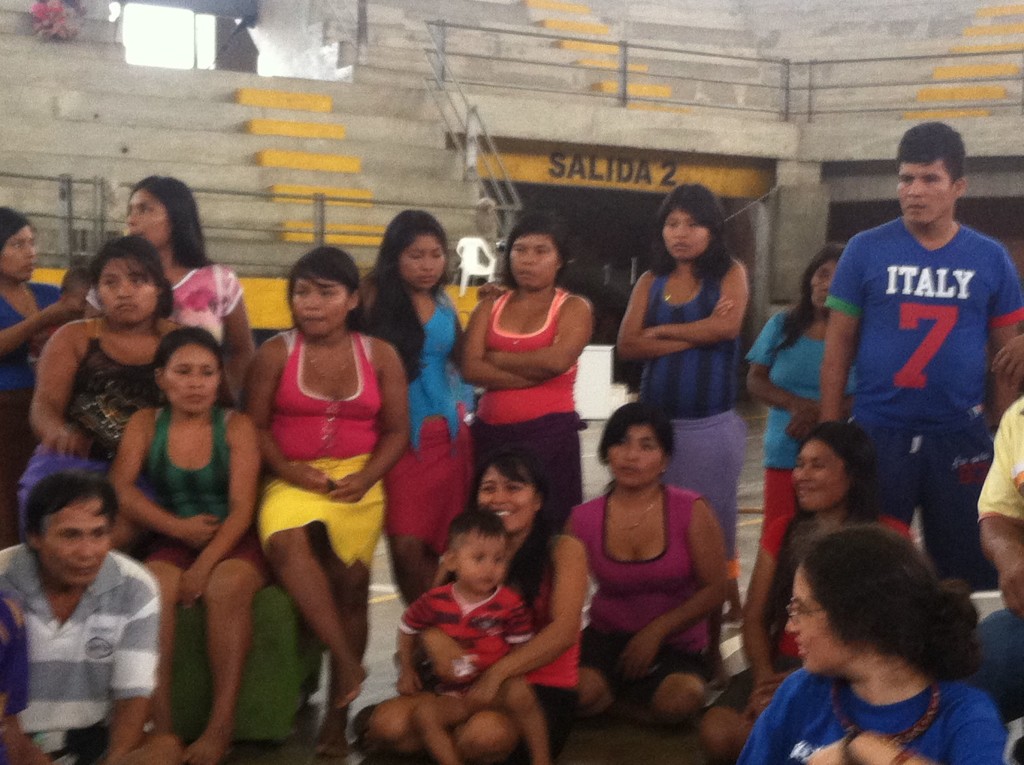
While in some cases, legal maneuvering and mobilization within Colombian Courts have served to defend indigenous landholdings, the year-long Wounaan occupation of El Cristal is a blatant recognition of the ineffectiveness of Colombia’s legislation and juridical processes. Innovative forms of resistance appeal to wider socio-political networks capable of eliciting support across local, regional, national and global borders; however, it comes with a price.
Rhizomic World
El Cristal Sports Arena was a far cry from the Wounaan’s rhizomic world of heterogeneity and its interconnected relations of all plant, animal, ancestral and human life living within its ecosystems. This dynamic cartography of interconnected networks mapped across their ancestral rhizomic river systems and landscape moves beyond western metaphysical notions of duality to foster a cosmos of inter-being. Wounaan livelihood and well-being rely on their interaction with their landscape, an animistic ethno-geographic interaction grounded in rhizomic thought in which “any point of a rhizome can be connected to anything other, and must be” (Delueze and Guattari 1988).
These beliefs further their kinship networks across time and space in a continuous state of growth in which identities and relationships extend and merge through a web of intersecting relationships. Bill Ashcroft explains the rhizome in biological imagery as multiplying “root system which spreads across the ground” from varying points reaching out across the nomadic space “rather than a single tap root” (1999).
For the Wounaan, the San Juan River is an essential organizing principle of their rhizomic networking system, rich in its biodiversity in which their cosmology interconnects them to 8000-9000 vascular plants, 577 bird species, 52 snake species, 45 lizard and allied species and 127 amphibian species—all inter-being in an ecosystem without hierarchies. In addition to its cohesive social networks, the San Juan River is the true river (döchaar) and ancestral homeland and thus a material feature in the development of their worldview and their perceptions of themselves (Velásquez Runk 2005).
The fluvial systems crisscross over a three-dimensional topography, which includes portals underworld, the real world and the celestial world. In this way their river-dominated cosmos reflects the comings and goings on the river up (marag), down (badag), to (jerag), and from (durrag) in a world where spirits, beings, plants and animals in the visible and invisible world live in a balance of reciprocal equilibrium (Velásquez Runk 2005).
Because of their metaphysical approach which links native individualities, political strategies, and traditional subsistence practices they have been able to maintain their traditional livelihoods and ways of being against the onslaught of land dispossession and acculturation (Velasco 2011). Although their rhizomic community is resistant to rupture where it has fissured and peoples are deterritorialized, the river’s organic networking systems have been capable of reattaching the Wounaan to people, plants, animals within its extended network or creating new connections across its geographical space (Kamash 2008).

Since the 1990s, the San Juan River’s fluvial systems have become reconfigured spaces in which flows of capital, commodities and contraband have brought in a host of nonlocal actors vying for spatial control of its strategic geographies. These vital commercial river networks, which connect the Colombian interior with the Pacific Coast are needed for the production and transportation of gold mining excavation and cocoa cultivation turning the once-peaceful rhizomic ecosystem into a bloody battleground between narco traffickers, gold minders, the FARC, the ELN, the Urabeños, the Rastrojos, and other left wing, right wing, and neo-paramilitary forces.
The result is not only the displacement of indigenous peoples and the disruption of the natural equilibrium of the Wounaan subsistent lifestyle, but the destruction of the biodiverse habitat in which its diverse resources have been transformed to commercial assets and mobilized for monocrop and gold production of surplus value. Added to the actors competing for resources is the introduction of new players from the National Development Plan hoping to position the San Juan River as a key geographic territory for the neoliberal exploitation of resources for free trade agreements. Dispossession for capitalist production has more importantly led to the desecration of ancestral homelands in which families are increasingly intimidated, disappeared and butchered by a collusion of local and nonlocal actors to expedite commodity commerce.
“The government said we are something in the way of development,” said Crelo Obispo further noting, “We’ve been attacked by our conqueror.” Another Wounaan spokesman added, “They want to exterminate us.” Whether it is death by paramilitary, death by narco trafficker, or death in the crossfire between guerillas and the army, there is one certainty as Crelo Obispo declares: There return to their homeland is precarious and must be “met with protection and dignity.”
Amidst these conditions are ongoing negotiations for a bilateral ceasefire between the Government and FARC. Although the Colombian government and FARC rebels have moved towards a comprehensive plan to end an ongoing civil war which, since 1964 has killed 220,000 people, the Wounaan have still been left out in the cold (Rodzinsky). Chama Puto points out that while they are negotiating in Havana, Cuba, “we had been ignored in all negotiation processes.” He believes that conflict resolution can result only when “the government negotiates with all its people.”
As of today, this has not happened and the people the color of the soil who turned their displacement into a political strategy of indigenous resistance to the destruction of their traditional ecosystems still struggle for survival. Chama Puto wants a governmental guarantee of protection and safety in order to survive on their ancestral lands. “We are done negotiating,” he said.
Forceful dispossession underpins the plight of the Wounaan whose homeland has been drained by capital’s international reach for resources in which a “free market exchange relies on and takes advantage of the political and cultural dispossession of certain subjects” (Hennessey 2013). How do indigenous people who make up two percent of Colombia’s population coexist in a global world that renders them disposable, inhuman beings? In this scenario, the two percent making up the indigenous groups of Colombia become eight percent of the dispossessed, displaced, and destined to misery as a form of “human waste”; sadly, a myth narrated and played out in the many parts of the globe.
In El Cristal, the Wounaan were separated from their means of subsistence and vigorously resisted all paradigms of commercial expansion and regional control of their economies—a pattern in which, “more than 5.7 million people have been internally displaced in Colombia since the start of recording official cumulative registration figure” (UNHRC 2015). As of 2014, Colombia’s National Victims’ Unit documented 97,453 cases of forced displacement, mostly along the Pacific region. The El Cristal crisis exposed the systematic layers of political collusion that render Wounaan territories disposable sites of exploitation and economic casualties, which dispossess its peoples from their traditional livelihoods for the benefit of both regional, national, and global markets.

Wounaan Resistance Strategies
Wounaan resistance strategies date back to colonization and manifested in their traditional tactics they implemented to maintain their sense of cultural dignity during their resistance campaign. While living in the Sports Arena women practiced small-scale artesanías in the form of colorful bracelets, necklaces, earrings, and small-carved wooden bowls. The unbroken practice of these customs created communal solidarity and furthered their economic livelihoods, traditional knowledge, and cultural sustainability (Velasco 2012). Although these courageous women were proud to sell their artisans to sports arena visitors, the transactions were soured by the reality of their dispossession. “Collectively and physically the living conditions” were “inadequate, the food inadequate.”
Wounaan resilience to reattach itself to its rhizomic rivers network is precarious and subject to intra-institutional support of regional and national control. It is yet to be seen if this latest mobilization strategy will provide any safeguards and protections for their community. “Promises have been unfulfilled and we have become strangers to ourselves,” sighed a wearied Obispo.
For more information, see CONPAZ.
References
Ashcroft, Bill (1999). “The Rhizome of Post-colonial Discourse” in Roger Luckhurst and Peter Marks (eds.) Literature and the Contemporary: Fictions and Theories of the Present, London: Longman pp. 111-125.
Deleuze, Giles, and Felix Guattarri (2007). A Thousand Plateus: Capitalism and Schizophreina. Brian Massumi, trans. Minneapolis; University of Minnesota Press.
Colombia, Información sobre Derechos Humanos y Libertades Fundamentales de la Poblaciones Indígenas presentada por el Gobierno. (Published in UN.E/CN.4/ Sub.2/AC.4/1991/4).
Hennessy, Rosemary. Fires on the Border. Hennessy, Rosemary. Fires on the Border: The Passionate Politics of Labor Organizing on the Mexican Frontera. Minneapolis: University of Minnesota Press, 2013. Print.
Kamash, Zena (2008). What Lies Beneath? Perceptions of the Ontological Paradox of Water, World Archeology 40 (2) 224-237).
Velasco, Marcela (2011). “Contested Territoriality: Ethnic Challenges to Colombia’s Territorial Regimes.” Bulletin of Latin American Research 30 (2): 213–228.
Brodzinsky, Sibylla. “ Colombia’s government and Farc rebels reach agreement in step to end civil war.” The Guardian. 15 Dec. 2015.
Runk, Julie Valasquez. (2005). And the Creator Began to Carve Us of Cocobolo: Culture, History, Forest Ecology, and Conservation among Wounaan in Eastern Panama. PhD dissertation, Department of Anthropology and the School of Forestry and Environmental Studies, Yale University and the New York Botanical Garden.
__________. (2009). Social and River Networks for the Trees: Wounaan’s Riverine Rhizomic Cosmos and Arboreal Conservation. American Anthopologist 111(4).
2015 UNRCR Country Operations Profile-Colombia. The UN Refugee Agency.

by DGR Colorado Plateau | Dec 24, 2015 | Listening to the Land, Lobbying
By Stephany Seay / Buffalo Field Campaign
Featured image: Hundreds of wild buffalo will no longer be harassed or otherwise harmed on the Horse Butte peninsula, seen in the distance here. Photo by Buffalo Field Campaign.
Yesterday, Montana Governor Steve Bullock issued his final decision on year-round habitat for wild bison in Montana, and Buffalo Field Campaign is very pleased to announce that after more than eighteen years of fighting for wild buffalo to freely roam Horse Butte, we have finally achieved this significant victory! As many of you know, Horse Butte is part of what we have been pressing for since the beginning of our campaign, and we are inclined to celebrate this achievement as the victory that it is; indeed, it may be the biggest victory we have had! It took nearly two decades of hard work in the field, in the courts, and in the policy arena to accomplish this, and it demonstrates how perseverance pays off, and how we must never give up.
This victory is a result of endless pressure, being endlessly applied by BFC, by you our dedicated supporters, by the incredible and active residents of Horse Butte, and by the buffalo themselves who consistently demonstrate resistance, persistence, and endurance. Another boon granted the buffalo is that bull bison — but only bulls — will be given year-round habitat in the Gardiner Basin. Please take a little time to celebrate this victory, as it has been hard-earned by each of you. Thank you to everyone who has been with us for the buffalo, making our work possible.
As we bask in this triumph, we cannot let down our guard. We must strengthen our resolve to continue fighting for wild buffalo and their right to roam the lands that are their birthright. We have many difficult battles yet to win. A closer look at Governor Bullock’s decision shows us that the buffalo are still in grave danger from livestock industry interests and the government agencies that serve them.
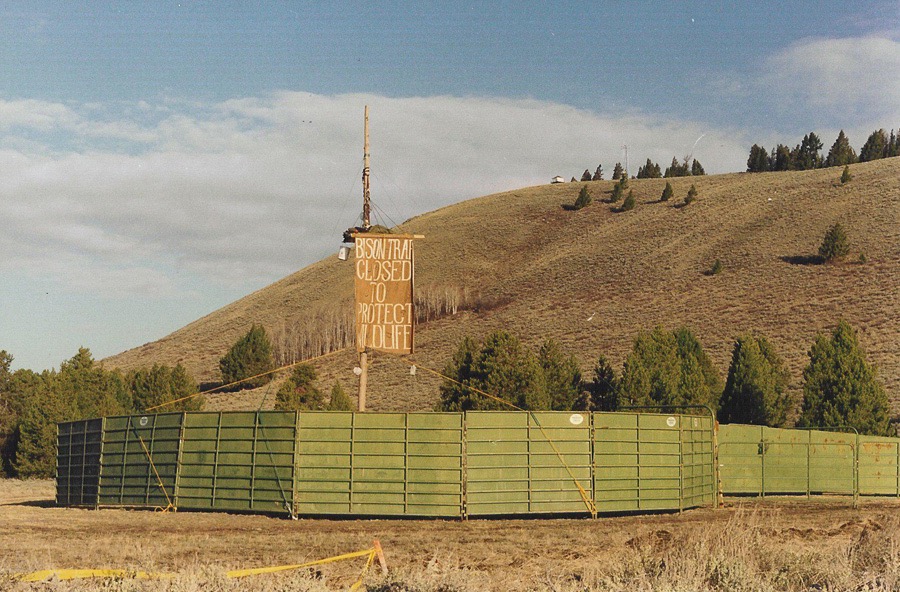
In 2004, the courageous and passionate Akiva Silver occupied the Horse Butte bison trap, saving many buffalo from being captured and shipped to slaughter. In 2008, the trap was again occupied by another brave individual, and the Montana Department of Livestock have not set it up since, nor will they ever again. Buffalo Field Campaign photo by Chris Rota.
Even the decision to grant buffalo year-round habitat on Horse Butte has its devilish details, mainly in the form of a population cap: during fall and winter approximately 450 buffalo will be allowed to live there; during the spring that number rises to 600, which is terrific timing since that’s when the large herds come to Horse Butte for calving season; but by July the government will allow only 250 buffalo to remain. From reviewing the Governor’s decision, it appears that, should there be more than 250 buffalo on Horse Butte by summer, hazing would not begin until then, which is about six weeks later than hazing has been taking place in recent years. While our ultimate goal is to put an end to all hazing, this means that wild buffalo will finally have the opportunity to make their own choices about when or whether to migrate into Yellowstone for the summer months. It will be an awesome gift to learn what they will do directly from the buffalo.
The deeper you look into the Governor’s decision, the more questions it raises. Hazing, hunting, and capture-for-slaughter remain tools that the livestock-backed government agencies will employ, with goals of keeping this highly vulnerable — and indeed, endangered — population at artifically low numbers. Additionally, wild buffalo will not be granted any “tolerance” along the south side of the Madison River, which is favored habitat, mostly public lands, that the matriarch-led family groups very much enjoy and require during the months surrounding calving season. Also, in the Gardiner Basin, matriarch-led family groups will not have full access like their adult male counterparts, but will be given tolerance only during “hunting” season, and will be hazed into Yellowstone by mid-spring.
Again, we have a long way to go for the buffalo. We need you to join with us in strengthening your resolve and renewing your commitment to do whatever it takes to defend our beloved wild buffalo until they roam free all across the lands that have been their home since buffalo time began.
Support Buffalo Field Campaign here.

 NWJA’s December 23, 2015 Lynden Tribune op-ed claimed that “the current leadership of the Lummi Nation has embarked upon a campaign against the working families of Whatcom County.” In an attempt to support that inflammatory claim, NWJA pointed to a December 10, 2015 letter from Kirk Vinish of the Lummi Nation’s Planning Department. However, a review of that 2-page letter produced no evidence to support such a claim.
NWJA’s December 23, 2015 Lynden Tribune op-ed claimed that “the current leadership of the Lummi Nation has embarked upon a campaign against the working families of Whatcom County.” In an attempt to support that inflammatory claim, NWJA pointed to a December 10, 2015 letter from Kirk Vinish of the Lummi Nation’s Planning Department. However, a review of that 2-page letter produced no evidence to support such a claim. On October 23, 2014, NWJA was filed as a non-profit corporation, according to the Washington Secretary of State website. SSA Marine’s paid local consultant for the GPT project, Bellingham resident Craig Cole, is the listed Director for NWJA.
On October 23, 2014, NWJA was filed as a non-profit corporation, according to the Washington Secretary of State website. SSA Marine’s paid local consultant for the GPT project, Bellingham resident Craig Cole, is the listed Director for NWJA. Since its inception, NWJA has had a steady turnover of co-chairs, all of whom have been very public advocates for the GPT project. Presently, Brad Owens is listed as NWJA President and John Huntley is listed as NWJA Chair. Huntley owns Mills Electric, a Bellingham electrical contracting company. Owens, a Bellingham resident, is the past President of the NW Washington Building & Construction Trades Council.
Since its inception, NWJA has had a steady turnover of co-chairs, all of whom have been very public advocates for the GPT project. Presently, Brad Owens is listed as NWJA President and John Huntley is listed as NWJA Chair. Huntley owns Mills Electric, a Bellingham electrical contracting company. Owens, a Bellingham resident, is the past President of the NW Washington Building & Construction Trades Council. According to the Washington Secretary of State website, ANWJE was filed as a non-profit corporationin July 2012. The “Governing Persons” listed are Todd O’Hair and Zak Andersen. Todd O’Hair is currently Senior Manager, Government Affairs for Cloud Peak Energy Inc. which has a 49% stake in SSA Marine/PIT’s GPT project. Zak Andersen is presently Assistant Vice President, Community and Public Affairs for BNSF Railway.
According to the Washington Secretary of State website, ANWJE was filed as a non-profit corporationin July 2012. The “Governing Persons” listed are Todd O’Hair and Zak Andersen. Todd O’Hair is currently Senior Manager, Government Affairs for Cloud Peak Energy Inc. which has a 49% stake in SSA Marine/PIT’s GPT project. Zak Andersen is presently Assistant Vice President, Community and Public Affairs for BNSF Railway.  BNSF is the applicant for GPT’s interrelated Custer Spur project and would be the railway transporting coal mined in Montana and Wyoming to GPT. ANWJE’s website describes its group as a “non-profit trade organization that supports new export projects in Oregon and Washington State…”
BNSF is the applicant for GPT’s interrelated Custer Spur project and would be the railway transporting coal mined in Montana and Wyoming to GPT. ANWJE’s website describes its group as a “non-profit trade organization that supports new export projects in Oregon and Washington State…”
















